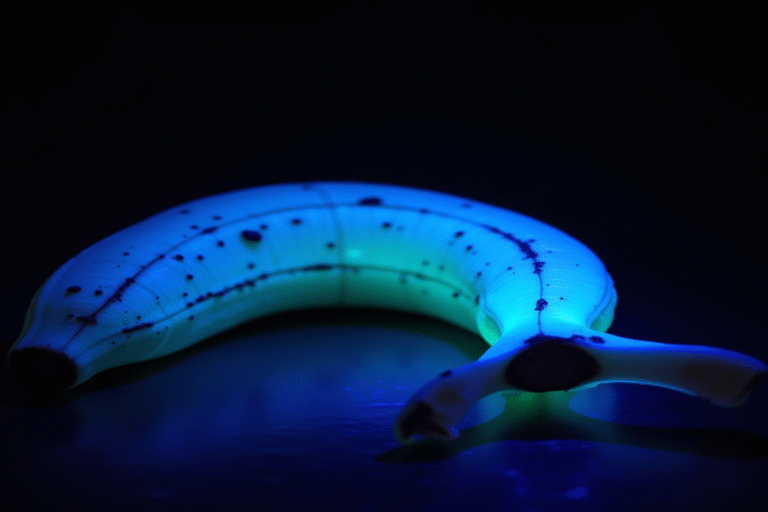Have you ever shined a blacklight on a banana? If you haven’t, you’re missing out on one of nature’s most surprising light shows. When placed under ultraviolet light, the familiar banana—a fruit we’ve all peeled countless times—transforms into something magical, emitting an eerie blue glow that seems more suited to deep-sea creatures than your kitchen counter.
The Glowing Mystery
This isn’t just a fun party trick—it’s a fascinating glimpse into the complex chemistry inside the fruits we eat every day. When exposed to UV light (wavelengths between 340-400 nm), ripening bananas emit a bright blue fluorescence that grows more intense as the fruit ripens. But why does this happen?
The answer lies in compounds formed when bananas ripen. As bananas mature, the chlorophyll (the green pigment responsible for photosynthesis) breaks down into several by-products, including fluorescent compounds known as chlorophyll catabolites. These catabolites have unique molecular structures that absorb invisible UV light and re-emit it as visible blue light, a process known as fluorescence.
The Science of Fluorescence
Fluorescence occurs when a substance absorbs light at one wavelength and immediately emits it at a longer wavelength. In simple terms, the molecule takes in high-energy light we can’t see (UV) and gives out lower-energy light that we can see (blue).
In bananas, this process is especially visible because:
- The peel contains high concentrations of fluorescent breakdown products
- These compounds are spread throughout the peel in a way that maximizes the effect
- The light-colored background of the peel makes the blue glow stand out clearly
Why Ripeness Affects the Glow
If you place bananas at different stages of ripeness under a UV light, you’ll notice something interesting: green bananas barely glow, while ripe and overripe ones with brown spots glow much more brightly. This happens because the breakdown of chlorophyll increases as bananas ripen, boosting the levels of fluorescent compounds in the peel.
Scientists think this might have an evolutionary purpose. Some theories suggest the increased fluorescence may have helped attract fruit-eating animals that can see in the UV spectrum, aiding in seed dispersal when bananas grew wild. Other researchers think it may simply be a by-product of the natural breakdown process, with no special evolutionary reason.
Beyond Bananas: The Fluorescent Food World
Bananas aren’t the only foods with glow-in-the-dark secrets. Several common foods show similar traits:
- Honey glows blue due to proteins and amino acids
- Tonic water shines bright blue because of quinine
- Some olive oils emit a greenish glow from chlorophyll and vitamin E
- White eggs glow reddish because of porphyrins in their shells
Practical Applications
This isn’t just a scientific curiosity. Food scientists use fluorescence to check fruit ripeness and quality. Special UV imaging systems can quickly determine the ripeness of bananas and other fruits without damaging them, making fruit sorting more efficient for growers and sellers.
Some researchers are also exploring whether changes in fluorescence can signal disease or contamination in fruits, which could lead to better food safety tools in the future.
Try It Yourself
The next time you have bananas at different ripeness stages, try looking at them under a blacklight (you can find these online or at party stores). You’ll see this remarkable chemical process firsthand—a reminder that even our most familiar foods hide extraordinary science just below the surface.
So next time you grab a banana in your kitchen, remember: you’re holding not just a tasty snack, but a small scientific wonder that bridges the visible and invisible worlds through the magic of light and chemistry.





